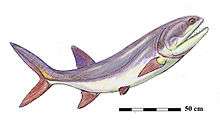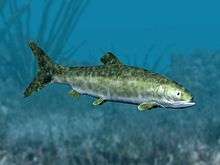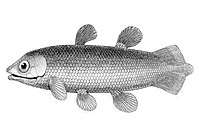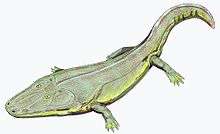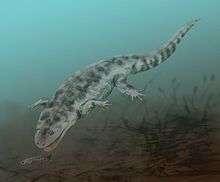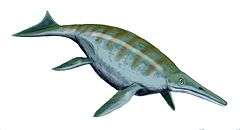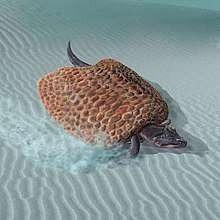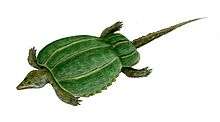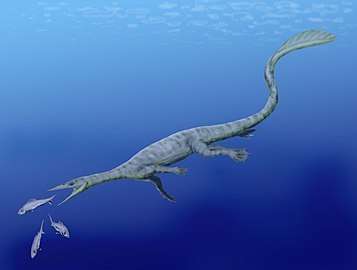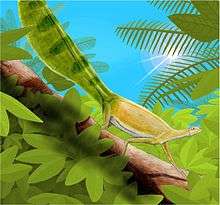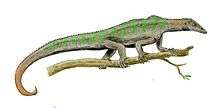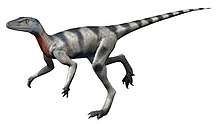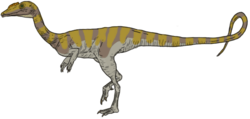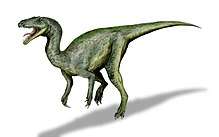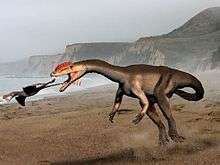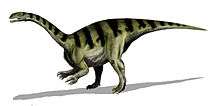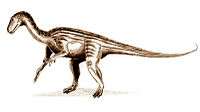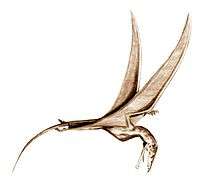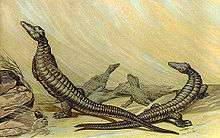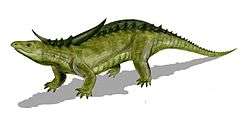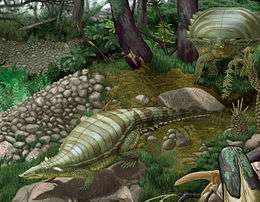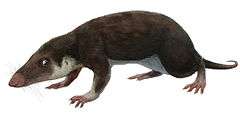Norian
The Norian is a division of the Triassic geological period. It has the rank of an age (geochronology) or stage (chronostratigraphy). The Norian lasted from ~227 to 208.5 million years ago.[2] It was preceded by the Carnian and succeeded by the Rhaetian.[3]
| System/ Period |
Series/ Epoch |
Stage/ Age |
Age (Ma) | |
|---|---|---|---|---|
| Jurassic | Lower/ Early |
Hettangian | younger | |
| Triassic | Upper/ Late |
Rhaetian | 201.3 | ~208.5 |
| Norian | ~208.5 | ~227 | ||
| Carnian | ~227 | ~237 | ||
| Middle | Ladinian | ~237 | ~242 | |
| Anisian | ~242 | 247.2 | ||
| Lower/ Early |
Olenekian | 247.2 | 251.2 | |
| Induan | 251.2 | 251.902 | ||
| Permian | Lopingian | Changhsingian | older | |
| Subdivision of the Triassic system according to the ICS, as of 2020.[1] | ||||
Stratigraphic definitions
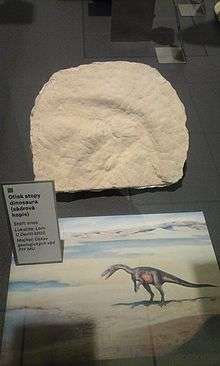
The Norian was named after the Noric Alps in Austria. The stage was introduced into scientific literature by Austrian geologist Edmund Mojsisovics von Mojsvar in 1869.
The Norian stage begins at the base of the ammonite biozones of Klamathites macrolobatus and Stikinoceras kerri, and at the base of the conodont biozones of Metapolygnathus communisti and Metapolygnathus primitius. A global reference profile for the base (a GSSP) had in 2009 not yet been appointed.
The top of the Norian (the base of the Rhaetian) is at the first appearance of ammonite species Cochloceras amoenum. The base of the Rheatian is also close to the first appearance of conodont species Misikella spp. and Epigondolella mosheri and the radiolarid species Proparvicingula moniliformis.
In the Tethys domain, the Norian stage contains six ammonite biozones:
- zone of Halorites macer
- zone of Himavatites hogarti
- zone of Cyrtopleurites bicrenatus
- zone of Juvavites magnus
- zone of Malayites paulckei
- zone of Guembelites jandianus
Norian life
†Ammonoids
| Ammonoidea of the Norian | ||||
|---|---|---|---|---|
| Taxa | Presence | Location | Description | Images |
| Norian |
 Pinacoceras | |||
|
Norian | |||
Chondrichthyans
| Chondrichthyes of the Norian | ||||
|---|---|---|---|---|
| Taxa | Presence | Location | Description | Images |
|
Triassic | United States, India | An xenacanth elasmobranch |
 Mooreodontus |
Actinopterygians
| Actinopterygii of the Norian | ||||
|---|---|---|---|---|
| Taxa | Presence | Location | Description | Images |
| Triassic | Italy | A non-neopterygian |
| |
| Late Triassic | Italy | A pycnodont | ||
| Late Triassic | Italy | A semionotiform | ||
| Late Triassic to Middle Jurassic | Austria, Italy | A neopterygian | ||
| Late Triassic | United States | A teleosteomorph (modern ray-fin) | ||
| Middle Triassic to Late Triassic | Austria, Italy | |||
| Late Triassic | Austria, Italy | A teleosteomorph (modern ray-fin) | ||
| Middle Triassic to Early Jurassic | Italy | A non-neopterygian | ||
| Late Triassic | Italy | A neopterygian | ||
| Triassic | Italy, Austria | A non-neopterygian | ||
| Middle Triassic to Late Triassic | Italy | The earliest gliding fish | ||
Coelacanths
| Actinistia of the Norian | ||||
|---|---|---|---|---|
| Taxa | Presence | Location | Description | Images |
| Late Triassic to Cretaceous | Italy | A coelacanth |
| |
Temnospondyls
| †Temnospondyls of the Norian | ||||
|---|---|---|---|---|
| Taxa | Presence | Location | Description | Images |
| Arizona | A genus of small metoposaurid trematosaurians, possibly juveniles of Koskinodon. | |||
| Chinle Formation, Colorado | Chinlestegophis is an extinct genus of possible stereospondylian, considered to be related to metoposauroids, and has been noted to share many features with caecilians, a living group of legless burrowing amphibians. If Chinlestegophis is indeed both an advanced stereospondyl and a relative of caecilians, this means that stereospondyls, as a clade, survived to the present day. | |||
| South America; South Africa; India; Australia | A genus of chigutisaurid brachyopoid trematosaurians. | |||
|
|
A genus of large mastodonsaurid capitosaurians. | ||
| All over the US and India | A genus of large metoposaurid trematosaurians. | |||
| India | A genus of chigutisaurid brachyopoid trematosaurians. | |||
| Continental Europe | A genus of large metoposaurid trematosaurians. | |||
†Procolophonomorphs
| Procolophonomorpha of the Norian | ||||
|---|---|---|---|---|
| Taxa | Presence | Location | Description | Images |
| Late Triassic | United States | A genus of lizard-shaped parareptile |
| |
†Ichthyosaurs
| Ichthyosaurs of the Norian | ||||
|---|---|---|---|---|
| Taxa | Presence | Location | Description | Images |
|
Nevada, USA |
| ||
†Placodonts
| Placodonts of the Norian | ||||
|---|---|---|---|---|
| Taxa | Presence | Location | Description | Images |
| Late Triassic | Spain |
| ||
†Thalattosaurs
| Thalattosauria of the Norian | ||||
|---|---|---|---|---|
| Taxa | Presence | Location | Description | Images |
| Late Triassic | Italy | An askeptosauroid |
| |
| Late Triassic | United States | A thalattosauroid | ||
†Drepanosaurs
| Drepanosauromorpha of the Norian | ||||
|---|---|---|---|---|
| Taxa | Presence | Location | Description | Images |
| Late Triassic | United States | A drepanosaur diapsid |
| |
| Late Triassic | New Mexico, United States | A drepanosaur diapsid | ||
| Late Triassic | Italy, United States | A drepanosaur diapsid | ||
| Late Triassic | United States | A drepanosaur diapsid | ||
| Late Triassic | Italy | A drepanosaur diapsid | ||
| Late Triassic | Italy | A drepanosaur diapsid | ||
Archosauromorphs
| Archosauromorphs of the Norian | ||||
|---|---|---|---|---|
| Taxa | Presence | Location | Description | Images |
|
Alaunian/Sevatian | Italy and Austria | A tanystropheid. | |
|
Löwenstein Formation; Trossingen Formation, both in Germany; Huai Hin Lat, Thailand; Fleming Fjord Formation, Greenland |
Proganochelys quenstedti is an extinct, primitive stem-turtle that has been hypothesized to be the sister taxon to all other turtles. | |||
| early Norian | Paleorrota, Rio Grande do Sul, Brazil | The latest surviving species of rhynchosaur, and the only one found in Norian deposits. | ||
Archosaurs
| Archosaurs of the Norian | ||||
|---|---|---|---|---|
| Taxa | Presence | Location | Description | Images |
| Pardonet Formation, British Columbia, Canada | Sikannisuchus is a genus of large archosaur. It is known from the a posterior portion of skull roof and from other fragmentary remains. | |||
| latest Norian to early Rhaetian | Lubliniec County, Poland | The relation of Smok to other archosaurs has not yet been thoroughly studied; it may be a rauisuchid, prestosuchid or ornithosuchid crurotarsan, part of the crocodile line of archosaurs, or a theropod dinosaur more closely related to birds. At an estimated 5 to 6 metres (16 to 20 ft) in length, Smok was the largest carnivorous archosaur in central Europe at the time. | ||
| Stubensandstein, Löwenstein Formation, Germany | A genus of rauisuchians originally thought to be a carnosaurian dinosaur. | |||
| Chinle Formation, New Mexico. | A rauisuchid. | |||
| All across Europe | Zanclodon is the name formally used for fossil material that might actually belongs to at least two genera of dinosaur from the Late Triassic among other genera. | |||
Dinosauromorphs
| Dinosauromorphs of the Norian | ||||
|---|---|---|---|---|
| Taxa | Presence | Location | Description | Images |
|
|
|||
| Carnian to Norian | Timezgadiouine Formation, Argana Basin, Morocco | |||
| Chinle Formation, New Mexico | ||||
| Eagle Basin, Colorado | ||||
| Carnian to Norian | Lossiemouth Sandstone Formation, Scotland | |||
| Cooper Canyon Formation, Texas | ||||
| Bull Canyon Formation, Texas | ||||
Dinosaurs
| Dinosaurs of the Norian | ||||
|---|---|---|---|---|
| Taxa | Presence | Location | Description | Images |
| 208 Ma | Avon, England | A disputed dinosaur known from an ilium, maxilla, astragalus, and humerus (it could be a chimera). Agnosphitys lies close to the ancestry of dinosaurs, although exactly where is disputed by researchers. Some consider it a saurischian close to the beginnings of dinosaur evolution, while others consider it a non-dinosaurian dinosauromorph. |
| |
| Early to middle Norian | Placerias quarry, Bluewater Creek Formation, Arizona | A close relative of the very similar Coelophysis, possibly belonging in the same genus. It is widely regarded as the oldest known neotheropod. | ||
|
Carnian to Norian | Chinle Formation, New Mexico, USA | Coelophysis was a small, slenderly-built, ground-dwelling, bipedal carnivore, that could grow up to 3 m (9.8 ft) long. Coelophysis is known from a number of complete fossil skeletons of the species C. bauri. | |
| Carnian to Norian | Chinle Formation, New Mexico and Arizona and Bull Canyon Formation, New Mexico | Genus of herrerasaurid dinosaur, measuring over 2 meters long. | ||
| Middle Norian | Löwenstein Formation, Keuper, Germany | Indeterminate coelophysoid theropod. | ||
| Disputed: Late Triassic or Early Jurassic, potentially as young as Sinemurian | Lower Elliot Formation, South Africa | A swift-running basal ornithischian that has the most complete known remains from any Triassic ornithischian, shedding new light on the origin of this group. One of the earliest known ornithischians, it sheds some light on early dinosaur relationships because early dinosaurs are known from mostly incomplete skeletons. Eocursor is known from partial skeletal elements, including skull fragments, spinal elements, pelvis, long leg bones, and unusually large grasping hands. | ||
| 210 Ma | Cooper Canyon Formation, New Mexico, USA | A large coelophysoid named after the giant monster movie character Godzilla. | ||
| Middle Norian | Löwenstein Formation, Keuper, Germany | Halticosaurus is a dubious genus of large theropod dinosaur. | ||
| 228-201.3 Ma, Norian to Rhaetian | Trossingen Formation, Thuringia, Germany | A coelophysoid that is the best represented Triassic theropod from Europe and one of the largest known. | ||
| 214-204 Ma, Carnian to Norian | Trossingen Formation, Bavaria, Germany | |||
| Los Colorados Formation, Ischigualasto-Villa Unión Basin, Argentina | Powellvenator was a coelophysoid theropod dinosaur. | |||
| Middle Norian | Löwenstein Formation, Keuper, Germany | A small coelophysoid theropod measuring about 1 meter long and 1kg heavy. | ||
| Dockum Group, Texas | Protoavis is a problematic and controversial dinosaurian taxon known from fragmentary remains. The fossils were described as being from a primitive bird by its original describer. Considered a chimera by most paleontologists. | |||
| 216 Ma | Trossingen Formation, Thuringia, Germany | A small coelophysoid theropod known from a single vertebra. Might be the same as Procompsognathus despite being based on a vertebra that is twice the size of the corresponding bone in Procompsognathus. | ||
| Norian | Ghost Ranch, New Mexico, US | One of the most basal theropods. Measured over 2 meters long. | ||
| Norian to Rhaetian | ||||
| 228-201.3 Ma, Norian to Rhaetian | Los Colorados Formation, Argentina | A medium-sized theropod. An adult skull, measured approximately 450 mm in length, suggesting a body length of approximately 4 m. | ||
†Pterosaurs
| Pterosaurs of the Norian | ||||
|---|---|---|---|---|
| Taxa | Presence | Location | Description | Images |
|
| ||||
Crurotarsans
| Crurotarsans of the Norian | ||||
|---|---|---|---|---|
| Taxa | Presence | Location | Description | Images |
| Lower Elliot Formation, Lesotho | ||||
| Los Colorados Formation, Argentina | ||||
| Löwenstein Formation, Germany | ||||
Aetosauria
| Aetosaurs of the Norian | ||||
|---|---|---|---|---|
| Taxa | Presence | Location | Description | Images |
| late Norian - Rhaetian | ||||
| Carnian - Rhaetian | ||||
Crocodylomorphs
| Crocodylomorphs of the Norian | ||||
|---|---|---|---|---|
| Taxa | Presence | Location | Description | Images |
| Late Carnian or early Norian | ||||
Lepidosauromorphs
| Lepidosauromorpha of the Norian | ||||
|---|---|---|---|---|
| Taxa | Presence | Location | Description | Images |
| Late Triassic | United States | A kuehneosaurid reptile |
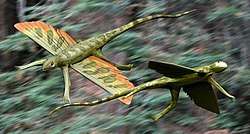 Kuehneosaurus (right) and Kuehneosuchus (left) | |
| Late Triassic | England, Luxemburg | A kuehneosaurid reptile | ||
| Late Triassic | England | A kuehneosaurid reptile | ||
Mammaliamorphs
| Mammaliamorphs[4] of the Norian | ||||
|---|---|---|---|---|
| Taxa | Presence | Location | Description | Images |
| Norian to Sinemurian | Greenland and Western Europe | A Late Triassic-Early Jurassic Kuehneotherian | ||
References
Notes
- "International Chronostratigraphic Chart" (PDF). International Commission on Stratigraphy. 2020.
- According to Gradstein et al. (2004). Brack et al. (2005) give 226 to 207 million years
- See for a detailed geologic timescale Gradstein et al. (2004)
- The genera listed are included in Mammalia by Kielan-Jaworowska et al. (2004) but not by those who restrict the taxon to the crown group.
Literature
- Brack, P.; Rieber, H.; Nicora, A. & Mundil, R.; 2005: The Global boundary Stratotype Section and Point (GSSP) of the Ladinian Stage (Middle Triassic) at Bagolino (Southern Alps, Northern Italy) and its implications for the Triassic time scale, Episodes 28(4), pp. 233–244.
- Gradstein, F.M.; Ogg, J.G. & Smith, A.G.; 2004: A Geologic Time Scale 2004, Cambridge University Press.
- Kielan-Jaworowska, Z.; Cifelli, R. L.; Luo, Zhe-Xi; 2004: Mammals from the Age of Dinosaurs, Columbia University Press.
- Martz, J.W.; 2008: Lithostratigraphy, chemostratigraphy, and vertebrate biostratigraphy of the Dockum Group (Upper Triassic), of southern Garza County, West Texas, Doctoral Dissertation, Texas Tech.
External links
- GeoWhen Database - Norian
- Upper Triassic timescale, at the website of the subcommission for stratigraphic information of the ICS
- Norges Network of offshore records of geology and stratigraphy: Stratigraphic charts for the Triassic, and
